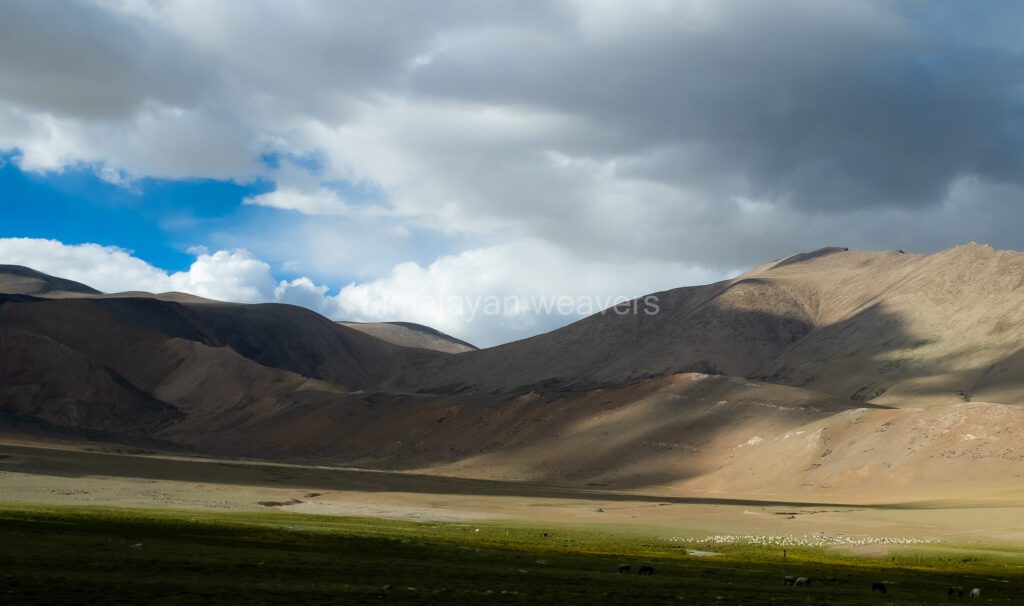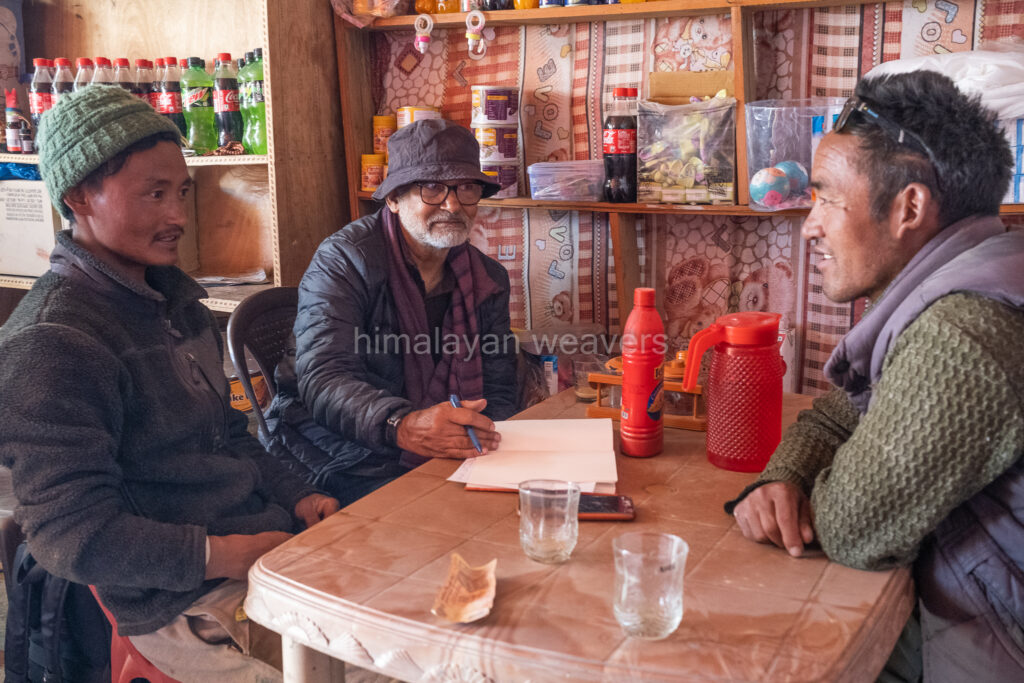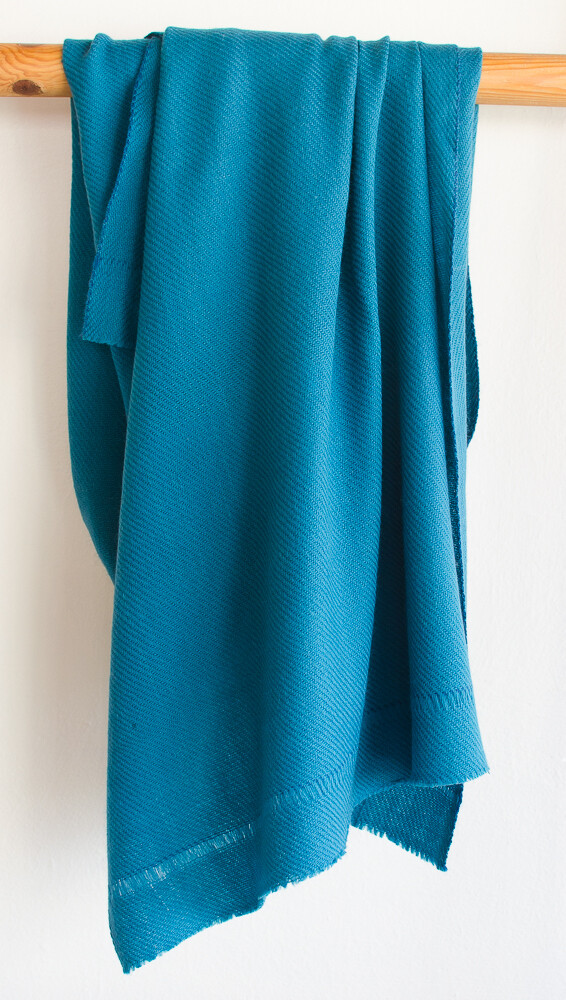Hand-woven woolen shawl dyed with indigo and tesu flowers
The shawl is made with a blend of Himalayan wool sourced from local farmers, and fine merino. The yarn is first hand-dyed with natural dyes and then handwoven into this beautiful shawl.
There may be small variations in size as it is made on a handloom. There may also be some inconsistencies in weaving and dyeing, which add to the character of the shawl. The length is about 90 inches (229 cms) and width 36 inches (91 cms). There are also tassels of roughly 4 inches (10cms) length.
We will ship the shawl within 3 working days of receiving the order. If you are in India, we will ship by a courier or Speed Post. If you are outside India, we will ship by DHL.
Enjoy!
Himalayan Weavers make beautiful pashmina shawls, stoles and scarves.
What is Pashmina?
Pashmina is the undercoat of goats which are found in some of the world’s harshest climates. The winter temperature in these places can be as low as -35 centigrade. In order to survive these extremely low temperatures the goats develop a very fine undercoat. This fibre is called pashmina.

Where is pashmina produced in India?
Most Indian pashmina is produced in the Changthang region of Ladakh, which is a high-altitude cold desert at heights of between 4000 and 4500 meters. The Changthang plateau is inhabited by pastoralist nomads called Changpas. As agriculture is difficult in these harsh conditions, Changpas mostly depend on livestock; they keep sheep, yaks and horses also, but Pashmina goats are their most important source of income.

The goats do not need their undercoats in the summer. So the Changpas comb them to gather pashmina, along with coarse hair. On average one goat produces between 150 and 200 grams of raw pashmina in a year. Before it can be used for spinning and weaving, it is necessary to separate the fine pashmina from the thick hair (a process called de-hairing). In the past this was done by hand. A large number of women in Srinagar and other pashmina shawl producing areas were engaged in this process. A number of mechanized dehairing plants have been set up in recent years and have almost completely replaced the manual de-hairing practice.
As the demand and price of pashmina has seen a steady increase, goats have become the most important source of income for Changpas. It is estimated that there are between 150,000 and 200,000 pashmina goats in Changthang, producing between 30 to 40 tons of pashmina every year.
The quality of pashmina is determined by the fineness ( measured in microns) and length of the fibre. To a large extent these depend on the altitude of the pasture lands and other micro-climatic conditions. In Changthang the best pashmina comes from Kharnak, Rupshu and Korzok. Most of our pashmina is produced in these villages.

Why are Our Pashmina Products Special?
Our pashminas are special for three reasons: we buy the best quality pashmina from a cooperative of Changpa nomads in Ladakh; our products are made with hand-spun pashmina; all our products are coloured with natural dyes.

In the past, the trade in pashmina was completely controlled by a handful of traders from Leh and Srinagar. Due to their strong position, they were able to buy pashmina at very low prices. In order to reduce the dominance of private traders, the government of Jammu and Kashmir has set up a cooperative society of pashmina producers in Changthang, called All Changthang Pashmina Growers Society. The Society is expected to improve the nomads’ earning. It also ensures that pashmina sold in the market is of high quality.
We buy our pashmina from the Cooperative Society.

Hand-spinning and weaving of Pashmina
Traditionally all pashmina products were made with hand-spun yarn. Thousands of women were engaged in preparing and hand-spinning pashmina in Srinagar and other parts of Kashmir The spinning was done on a traditional charkha. Sadly, in recent years, mill-spun yarn has almost completely replaced hand-spun pashmina yarn. While this has helped to reduce the production cost, there has been a large-scale de-skilling of artisans in Kashmir. Although some efforts have been made in Kashmir to revive pashmina hand-spinning, most pashminas are made with mill-spun yarn. Also, most of these are machine-woven in mills.
All pashmina shawls, stoles and scarves made by Himalayan Weavers are hand-woven on traditional looms, using yarn hand-spun by women in Rajpur village, where we are based. To improve the productivity and income of these women, we have designed and built an efficient charkha which is ideal for working with pashmina.
Pashmina Coloured With Natural Dyes
We believe in sustainable and slow fashion. A great attraction of our pashmina and other products is that we don’t use chemical dyes; we use only natural dyes, mainly madder, indigo, shellac tea, harada and tesu flowers.
We have a small in-house facility in the mountains to hand-dye wool and pashmina yarn. The dying process is adapted to reduce the use of water and energy.



